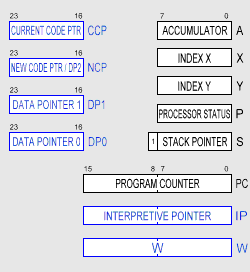LAUGHTON ELECTRONICS |
|
 |
This is the story of an extremely unusual microcomputer. An industry-standard CPU chip is enhanced by off chip circuitry — a coprocessor — that boosts the machine's capabilities into a different class. |
 |
|
| Introduction | |
|
KimKlone programming model. The new registers are shown in blue. |
This article
describes a computer which I built 20 years ago as a whimsical exercise
in Computer
Science and
as a commonplace tool for use in my lab. The article explains the
machine's capabilities and also the intriguing manner of their
implementation. Despite reliance on external logic, the machine
responds to the programmer just as aptly as a redesign carried out at
the silicon level. The KimKlone represents an architectural extension of the 65C02. The most striking improvement is efficient linear access to a 16 Mbyte Address Space. Also on the short list is hardware acceleration for the Forth programming language, including a one-byte NEXT instruction and a new, stack-savvy addressing mode. To exploit these and other capabilities, the programmer has access to new instructions and new registers. (See the programming model, left.) The new instructions aren't interrupts or traps to emulation routines. Nor are the new registers merely an over-glorified MMU (Memory Management Unit), the sort of thing that's inoperable except via peeking and poking with I/O accesses. The KimKlone actually has brand new instructions, to which the new registers implicitly respond. The novel instructions execute inline and at full speed. There are 44 new op-codes, all mapped into the Undefined spaces in the Rockwell 65C02 op-code map. (More on op-code mapping later.) This article is organized as shown in the Contents section below. I should mention that the machine's nickname, "KimKlone," may be misleading. The KimKlone has almost nothing in common with a MOS Technology KIM-1. The nickname arises simply because some of the concepts were first explored on my heavily reworked KIM-1. Also, the reference to "Cheap Video" in the article title is a nod to author Don Lancaster. The Kimklone and my KIM-1 both include mutations of the audacious Lancaster video interface, and his books helped foster my own outside-the-box design approach. See Cheap Video à la Lancaster, and The Back Story re: KIM-1The KimKlone is a
fascinating device. If you find it a little "over the top," be
aware that
I too am amused by how it turned out. This lowly lab computer took on a
life of its own while it was still on the drawing board. |
| Next Page > | |
visit LAUGHTON ELECTRONICS |
Home Commercial& Manufacturing Stage&Studio Laboratory&OEM |
 |
|


